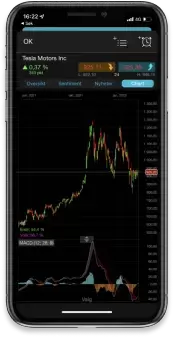Apple’s [AAPL] share price has dipped this year amid investor concerns over consumer spending and the worsening global economic outlook. When markets closed on Friday 21 October, the Apple [AAPL] share price was down 19.1% year-to-date at $147.27, compared to a 31.5% drop for the Nasdaq 100, of which Apple is the largest constituent by market capitalisation.
Although Apple stock has lost almost a fifth of its value this year, the iPhone maker’s tech peers have endured even steeper share price declines. Microsoft [MSFT] is down 27.7% so far this year, Amazon [AMZN] has decreased 30%, while Google owner Alphabet [GOOGL] has fallen 30.3%. Shares in Facebook owner Meta Platforms [META] have slumped 61.6% over the same period.
So, as Apple gears up to release fourth-quarter results on Thursday, we look at why shares in the Cupertino-based company have outperformed those of its rivals this year.
Apple retains long-term growth potential
There are various reasons why Apple stock has not been sold off to the same extent as several of its peers in 2022. These include the company’s popular product offering, its strong brand and its moves into areas such as self-driving vehicles, healthcare and electronic payments.
Personal finance has been a particular area of focus recently. As the Financial Times reported earlier this month, Apple is deepening its ties with Goldman Sachs as the two businesses co-operate on the launch of a new high-interest savings account for Apple Card customers.
Furthermore, Apple returns a regular dividend to shareholders, paying out $0.23 per share in each of the last two quarters.
Revenue and earnings also remain robust. In Apple’s third quarter – the three months to 25 June – revenue came in at $83bn, in line with analyst estimates, while earnings per share (EPS) were $1.20. For Q4, analysts expect EPS of $1.26, according to data collected by Zack's Investment Research, up from $1.24 in the same period a year ago.
Looking further ahead, analysts expect EPS of $6.50 for the year to 30 September 2023, according to Zack's. Based on Friday's closing price of $147.27, Apple’s forward-looking price-to-earnings (P/E) ratio is therefore 22.66.
That represents something of a premium, but given the company’s long-term potential to grow in new and emerging business areas, many investors continue to see value in that multiple.
Rising cost of living could impact sales
One near-term risk facing Apple is the cost of living crisis, which could impact consumers’ willingness to fork out for pricey devices. In the final three months of 2022 – the first quarter of Apple’s new financial year – it will be interesting to see how demand for iPhones, iPads and Macs holds up as domestic bills soar and many people economise. If consumers decide to hold off on that new iPhone 14 or Apple Watch upgrade in the run-up to Christmas, it could dampen what tends to be Apple’s best quarter of the year.
The initial signs certainly seem to point to a weakening of demand. Last week Apple cut production of its recently launched iPhone 14 Plus, a mid-range alternative to the more expensive iPhone 14 Pro, while it “re-evaluates demand”, according to a report by tech news site The Information. The news caused Apple shares to dip 3% before recovering. Last month analysts at Jefferies reported that shoppers in China, where lockdowns have blunted consumer spending this year, bought fewer iPhone 14s in the days after its release than the device’s predecessor a year ago.
Despite these concerns, analysts retain a positive outlook on the tech giant. The views of 43 analysts, as compiled by the Financial Times in October, show that 11 analysts rate the shares a ‘buy’ and 26 rate them ‘outperform’, with five ‘hold’ ratings, one ‘underperform’ rating and no ‘sell’ ratings. Among the 40 analysts who offered price forecasts, the median 12-month price target was $185, representing a 25.6% increase on Friday’s closing price of $147.27.
Although a Q4 earnings miss or weak Q1 sales could weigh on the Apple share price in the near term, the company’s long-term prospects continue to appear positive. As ever, then, industry watchers, investors and traders will be all ears when Apple reports Q4 results after US markets close on Thursday 27 October.
Disclaimer: CMC Markets is an execution-only service provider. The material (whether or not it states any opinions) is for general information purposes only, and does not take into account your personal circumstances or objectives. Nothing in this material is (or should be considered to be) financial, investment or other advice on which reliance should be placed. No opinion given in the material constitutes a recommendation by CMC Markets or the author that any particular investment, security, transaction or investment strategy is suitable for any specific person. The material has not been prepared in accordance with legal requirements designed to promote the independence of investment research. Although we are not specifically prevented from dealing before providing this material, we do not seek to take advantage of the material prior to its dissemination.







